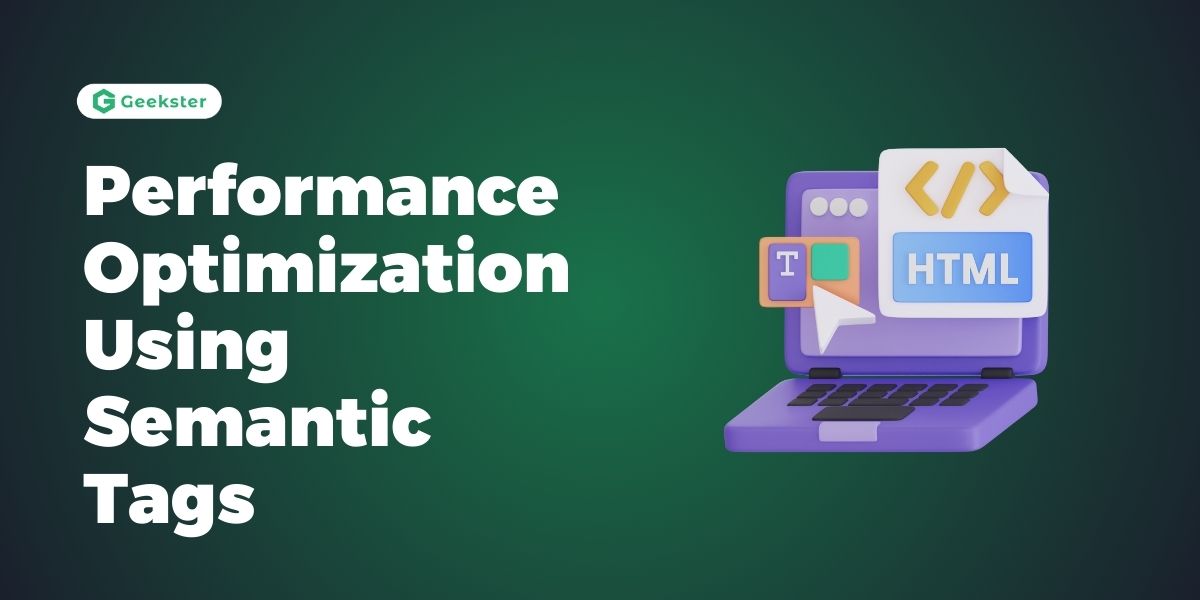Introduction
As developers continue to look for ways to make web experiences faster and more efficient, optimization keeps being a top priority. Among the many ways in which optimization can be done, the use of semantic tags in HTML is most frequently overlooked. Semantic tags not only increase accessibility and SEO but also improve performance. In this article, we explore how semantic tags can improve web performance and share practical tips for implementation.
Role of Semantic Tags in Web Performance
Semantic HTML tags provide context to the content of the page so that the structure and meaning can be better understood by both browsers and developers. Some examples of the semantic tags are <article>, <section>, <nav>, <header>, <footer>, and <aside> . These, compared to non-semantic tags like <div> and <span>, have quite a few performance advantages:
1. Improved Accessibility: The semantic tags ease navigation for screen readers and other assistive technologies. The direct mapping reduces the overhead of additional ARIA (Accessible Rich Internet Applications) attributes.
2. Better SEO: Search engines will give preference to content that is well-structured. Semantic tags provide an opportunity for search engines to better understand the content’s hierarchy and context, increase indexing, and potentially lead to better search rankings. Improved SEO indirectly boosts performance through an increase in organic traffic without additional server resource requirements.
3.Reduced JavaScript: By using semantic tags, developers can reduce the amount of JavaScript needed for tasks like navigation and content discovery. Semantic tags provide a clear structure that can be easily manipulated with minimal JavaScript, leading to faster load times and improved performance.
Practical Tips for Using Semantic Tags
Use Appropriate Tags
Replace generic <div> and <span> tags with semantic equivalents where appropriate. Here’s an example:
Before:
<div id="header">
<div class="logo">My Site</div>
<div class="nav">
<a href="#">Home</a>
<a href="#">About</a>
<a href="#">Contact</a>
</div>
</div>
<div id="main-content">
<div class="post">
<h2>Post Title</h2>
<p>This is a blog post.</p>
</div>
</div>
<div id="footer">
<p>© 2024 My Site</p>
</div>After:
<header>
<div class="logo">My Site</div>
<nav>
<a href="#">Home</a>
<a href="#">About</a>
<a href="#">Contact</a>
</nav>
</header>
<main>
<article>
<h2>Post Title</h2>
<p>This is a blog post.</p>
</article>
</main>
<footer>
<p>© 2024 My Site</p>
</footer>Maintain a Clear Structure
Ensure your HTML documents have a logical, hierarchical structure. This not only makes the content more accessible but also enables browsers to render the page more efficiently.
Example:
<main>
<section>
<header>
<h1>Main Section</h1>
</header>
<article>
<header>
<h2>Article Title</h2>
</header>
<p>Article content goes here.</p>
</article>
</section>
</main>Optimize Content Loading
Semantic tags can work hand-in-hand with lazy loading strategies. For example, using <picture> and <figure> tags for images along with the loading="lazy" attribute can defer loading of offscreen images until they are needed.
Example:
<figure>
<picture>
<source srcset="image.webp" type="image/webp">
<img src="image.jpg" alt="Description of image" loading="lazy">
</picture>
<figcaption>Caption for the image</figcaption>
</figure>Leverage Browser Optimization
Modern browsers can optimize rendering and styling based on semantic tags. For example, <main> indicates the primary content, allowing browsers to prioritize its rendering over less critical elements.
Example:
<!DOCTYPE html>
<html lang="en">
<head>
<meta charset="UTF-8">
<meta name="viewport" content="width=device-width, initial-scale=1.0">
<title>Optimized Web Page</title>
<style>
body {
font-family: Arial, sans-serif;
}
main {
padding: 20px;
}
</style>
</head>
<body>
<header>
<h1>My Website</h1>
<nav>
<ul>
<li><a href="#">Home</a></li>
<li><a href="#">About</a></li>
<li><a href="#">Contact</a></li>
</ul>
</nav>
</header>
<main>
<article>
<h2>Article Title</h2>
<p>This is the main content of the article.</p>
</article>
</main>
<footer>
<p>© 2024 My Website</p>
</footer>
</body>
</html>Simplify CSS and JavaScript
Semantic HTML reduces the need for complex CSS selectors and JavaScript DOM manipulation. Simple, semantic markup can lead to cleaner, more efficient code.
Example:
CSS Before:
#header {
background-color: #f8f9fa;
}
#header .nav a {
margin: 0 10px;
}CSS After:
header {
background-color: #f8f9fa;
}
nav a {
margin: 0 10px;
}JavaScript Before:
document.getElementById('main-content').innerHTML =
'<div class="post"><h2>New Post</h2><p>This is a new post.</p></div>';JavaScript After:
document.querySelector('main').innerHTML =
'<article><h2>New Post</h2><p>This is a new post.</p></article>';Conclusion
Every optimization counts in a dynamic landscape of web development. Semantic HTML tags provide a simple yet powerful toolset for reducing web performance while at the same time improving accessibility and SEO. By using semantic tags such as <header>, <nav>, and <main> to structure content, developers clarify the hierarchy of the document, allowing browsers and assistive technologies to interpret and render content in a more intelligent manner. This doesn’t only provide clarity within HTML but also reflects on better practices for CSS and JavaScript, leading to faster loads and a better user experience. Embrace semantic HTML not as a convention in coding but as a strategy for building high-performing, accessible, and future-proof web applications.
Frequently Asked Question
Semantic HTML provides a clear structure to web documents, making it great for browsers to go through and render the content very efficiently. This structured approach can reduce the need for excessive JavaScript and CSS manipulation, leading to faster load times and an increase in overall performance.
The semantic tags <header>, <nav>, and <main> give meaningful labels to different sections of a web page, facilitating the work of assistive technologies, particularly screen readers, in navigating and interpreting content on the page. The creation of a better, more accessible website for people with disabilities is one of the many benefits developers can expect to derive from using semantic HTML.
Yes, semantic HTML has the potential to impact SEO positively. Search engines such as Google tend to prefer good document structure, and semantic tags contribute to an understanding of the context and hierarchy of the content on a web page. It results in better indexing and probably better search rankings.

